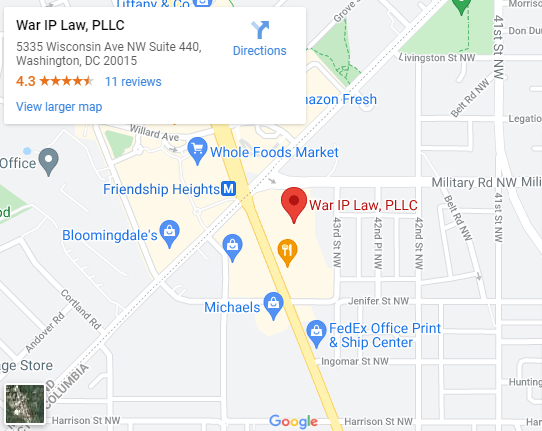Protecting intellectual property may sometimes be trickier than protecting the integrity and ownership of real property. Intellectual property (IP) theft, unlawful distribution or use, such as plagiarism, can be harder to prove than the appropriation of real, tangible property due to the nature of intellectual property. Understanding the key characteristics of real property vs. intellectual property is essential to effectively navigating the necessary protections. An intellectual property protection lawyer from War IP Law PLLC, can help build legal protections for IP owners, including by filing for patents, trademarks. And copyrights and advocating for IP owners in trademark and patent disputes. Contact us today at 202-902-6362 to learn more.
How Is Intellectual Property Different From Other Property?
According to the International Trade Administration, at its heart intellectual property is the expression of creative ideas. While it is very difficult to prove ownership of the underlying idea, creators, and inventors may file for exclusive ownership and use of their expression of the idea. No one can own the colors red and white, the letters C, O, K, and E, nor a swirl design. The Coca-Cola company owns exclusive rights to the red-and-white Coke logo, using these elements, but not the elements themselves.
Identifying ownership of tangible goods is simple: The goods are in the owner’s possession, or the owner can legally prove ownership of the goods through a title transfer or other documentation. Defining IP ownership is in some respects similar––the creator may file a patent, copyright, or trademark to own the creation––but proving that another party is unlawfully using or in possession of the IP can often venture into complex legal territory.
Protecting Ownership of Intellectual Property
IP protections in the United States are only valid in the United States; any IP protections issued in this country will not extend to protecting the item in other nations. Protecting the ownership and integrity of IP is the responsibility of the property owner. Before filing for IP protection, it is helpful to conduct thorough research in order to be sure the IP is not already legally protected.
If you are unsure how to get started, contact an IP attorney from War IP Law. Our legal team can:
- Correctly search for, clarify the type of, and properly define the extent of an IP filing
- If your IP is unique, and a similar item is not registered, then we can file for the appropriate type of protection for the IP type with both domestic and foreign governments
- Police the integrity and use of your IP, including its use (and misuse), managing it, and affording ongoing cultivation of your intellectual property rights
- Draft licensing agreements in your best interest and review any licensing agreements presented to you
Our legal team focuses on ensuring that your IP is well-protected and any proposed use of it is in your best business interests.
The Difference Between Real Property and Intellectual Property
Real property is a tangible asset with a transactional monetary value. Nearly all real property is in physical form and can be assigned finite monetary value. In some cases, it may be easier to identify and assign protections to real property vs. intellectual property due to the nature of the real property.
Intellectual property, on the other hand, comprises intangibles owned by an individual or an organization and protected from outside use by another party. IP may have a variable monetary value, depending on the exclusivity of the item. For example, some IP can grow in value as it becomes rarer, like first editions of books, while other IP may become much less valuable once it is widely used and distributed, such as an item that becomes public domain after the expiration of a patent.
How Do You Understand Intellectual Property?
The United States Department of Commerce explains that the concept of intellectual property is twofold:
- Protecting creations from appropriation or misuse not intended by the creators
- Stimulating the development of new services or products by inventors and creators
The United States Department of State indicates that IP protections extend to preventing the exploitation of creative content and intangible assets by parties other than the owner or parties to whom the owner has given permission to use or reproduce the content or creation.
What Are the Four Types of Intellectual Property?
Legally speaking, intellectual property falls into four broad categories. The United States Patent and Trademark Office provides guidance on the with a specific legal protections that apply to each:
Patents
Patents grant a party the right to prevent others from using an invention belonging to the patent-holder, unless the patent is licensed to a third party. Patents usually last for 20 years; once the patent expires, the invention becomes open to general use. During the life of the patent, other developers or scientists may build up or improve the design and function of the invention within the boundaries set by the patent owner; afterward, any company may use or alter the invention as it sees fit. Computer software, machines, or cosmetics are examples of patentable items.
Trademarks
A trademark is a distinguishing mark that enables the public to identify the source of a product or service, such as the Coca-Cola’s red and white design mentioned above. Trademarks can be:
- A picture
- A word or phrase
- A sound or smell
- A symbol
Or any other mark that distinguishes the brand. Consumers can quickly identify certain brands by their trademarks.
Copyrights
A copyright grants exclusive rights to the author or creator of a creative work. The work must be in a fixed, tangible medium, such as:
- Computer programs
- Books, screenplays, or plays
- Paintings, sculptures, or photographs
- Music, movies, TV shows
- Architectural works
A copyright protects the created work itself, but not the inspiring idea alone, nor any facts or functional part of the work (like words in a book or music notes). A copyright also protects derivations from the copyrighted work.
Trade Secrets
A trade secret is a piece of proprietary information that gives a business a specific, unique advantage over competitors. This could include a recipe unique enough to make an edible product or cosmetic stand out from similar products or a process of creating a tangible good. The information is valuable because its knowledge is limited, and disclosing the knowledge would decrease the value of the finished product or even destroy it.
Seek Help From an Experienced Business Attorney in Protecting Your IP
Achieving protection for your intellectual property, no matter which form it takes, is markedly different from placing protections around real property. The IP attorneys at War IP Law PLLC, help creators, inventors, businesses, and brands understand the type of protection they need for their intellectual property, proprietary information, and other branding. Contact us today at 202-902-6362 to learn about your legal protections.






